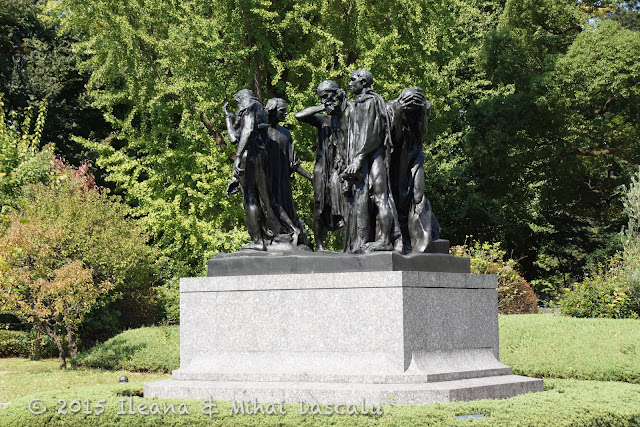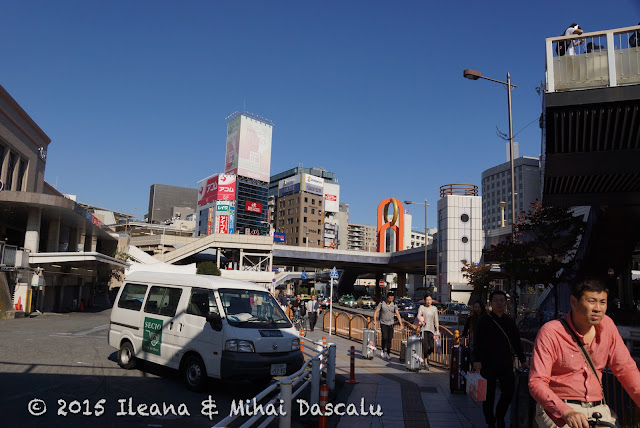Today we start our morning early, but we stay in. I take advantage of Ioan’s school and wash more laundry, and do small things.
When we finally emerge from our apartment, we take the subway to Ueno Park. Next to a bus station there is a big map of the park. Though we have an ipad and internet and we could orient ourselves from that, we choose to look at that map. And while we are looking at it, I notice two men, quietly washing its frame, small movements, no drips. If we wouldn’t have stopped to look at the map, I wouldn’t have known that they were there, working. But as we are here, I feel like I am not letting them work. It amazes me, because in my mind I compare it with a similar one in Romania or in USA (not that I have seen or heard of washing the frame of a street map). In Romania, IF someone would do this job, it would be visible from a distance, an obvious fuss, “Look at me, I’m working”. In USA no one would bother, that’s why we have rain, but, still, if they would have to do it, they would use a power washer.
First stop: National Museum of Western Art. We know that the building is on the waiting list of World Heritage Sites. It was build by Le Corbusier in 1951 to house the Matsukata collections.
Kojiro Matsukata (1865-1950) was the son of a politician (who rose to the Prime Minister position during the Meiji Restoration). He studied law at Yale and accumulated a large fortune through shipbuilding. During the First World War he started collecting artwork and he amassed quite a fortune. His business was affected by the downturns of the 1920 and 1930, and he had to sell some of his collections. At that time Japan was imposing 100% tariff on the art imports, and so Matsukata left his collection stored some in London (were they burned in 1939) and some in Paris, in the facilities of Musee Rodin. Second World War came, the property was seized. Eventually, the majority of it was released, but to the Japanese people. And in 1959, in a just finished building, and around it, people could see what was dear to him.
 |
| Rodin — The Burghers of Callais |
 |
| Rodin —Gates of Hell and Bourdain — Hercule, the Archer |
Here you can take a virtual tour of the museum. It takes a while to understand how to press the arrows so you can move around the floor, and I could not figure out what am I looking at, but maybe you do, and you could enlighten me too.
We leave the museum refreshed, energized by the western, modern beauty that is so accessible to us. We could have stayed longer but we want to visit the National museum. So we walk in the Ueno Park, past a Christian religious service for the homeless. It is so unexpected! In my mind, the Japanese people (who have such an order in their lives, and customs, and rules) don’t have homeless people. Confronted with reality, I am uneasy. I look at them: the homeless seem to participate, standing orderly, answering. A woman, probably with the people who organized the event, seems to conduct them. I have a gut feeling of “we are going with it, because in the end we receive what we want”.
We arrive at the National Museum but alas, it is closed. It was open yesterday, for the Happy Monday, … It is true that we have seen it last time, but only the collection for the “tourists”. We would have liked to visit the other parts, but some other time…
 |
| The building behind is the Tokyo National Museum. |
 |
| Picnic in Ueno Park on newspaper. |
We walk on streets that survived the WWII bombings. The houses have a different feeling, smaller, simpler, dated. Some temples and some cemeteries in which identical wooden buckets (used for the washing of the tomb), with the family name written on it, are stacked at the entrance.
We pass by the Zoo, admire the rail-train. We are looking for a special lake, the guidebook says so, but it is closed in for some works. We take the upwalk to cross a very busy street and there are many sounds, and people, that seem to crowd me in. Fortunately we get home and eat some MSG soups and have some rest.
 |
| The restroom, outside the Ueno Park, near the Zoo. |
 |
| The upwalk that leads to Ueno Station |
 |
| Marker for Ueno Station |
At 4:30 pm we leave again to the Sensō-ji temple. It seems that everyone got out in the streets: the students are done with their school work for the day, people are on their way home, tourists visit. And it seems that they are all here: some linger, some pray, some read their fortune. There is a hexagonal elongated box in which there are 64 sticks, each with their markings. A boy wants to know what is in his future: he takes the box, shakes it while he thinks of what he wants to know, and through the small opening on the top he removes one stick. After he reads its markings he puts the stick in the box, and the box back in its place. Then he goes to an organized shelf where he finds the paper that has the same markings. On it, his future is written (his or any other person’s who draws that stick). Mixed in the crowds is one man who supervises the students and he is ready to intervene if their joyful expansiveness transforms into rowdiness. The temple in itself tells us nothing, it has the same Japanese feeling, ordered, lacquered, symmetrical, perfect. Mihai tells me we are here for the atmosphere. From the top of the stairs we can see the whole pedestrian boulevard leading to the gates of the temple: it is hemmed with lights that sit above the food stalls and people flow in both directions.


 |
| A hundred yen to know your future, you have only 64 choices! |
 |
| Huge temple doors, you can see them behind Mihai and myself in the above picture. |
At one food stall one man fills pagoda shaped matrices with a liquid and then adds a blob of red bean paste mixed with sugar, heats them over the fire, and while they are cooking, he fills other matrices with the liquid. When the first ones are done, he just moves them, upside down, over the freshly filled ones and that’s how he gets small pagoda shaped waffles. We buy some, just for fun and burn our mouths, they are so hot. But they are good. We move with the crowd, observing it: every cliche that we know it’s here from hair styles, to clothes, to gadgets. And they are ALL crossing my personal space.
In a way I feel like Gulliver in Blephusku: I am tall and they are sooo many. The apartment feels small, in the subway the seats are small and all the holding bars are across my face. Everything is small if I compare it with me. The night is young… we’re going to Shibuya!
Being in Tokyo means that we get to visit our friends, Doru and Ana. I ask Mihai where do we meet? Shibuya Station. WHERE in Shibuya Station, because that is a very important hub and it has several levels, and how are we going to recognize the meeting place (a panic feeling freezes my guts)? At Hachi’s Statue. What? Where is that? Google maps to the rescue, and we move in a darkness illuminated by neons between Manga characters, workers, tourists, checking from time to time the screen, and we’re right on spot! We lift our eyes from the screen, and a few feet away, there it is: Hachi’s statue.
 |
| Though it says "How to buy a subway ticket" it is more complicated to choose the ticket to get you where you want to go. |
Hachi was an Akita dog who waited for his master every day at the Shibuya train station, even after his master died. He was present at the unveiling of his statue, though not this one because the original was recycled for the war effort. He died of cancer and his ashes are buried next to his master’s. I knew some of these things from the movie Hachikō Monogatari, and from the American remake Hachi (with Richard Gere). I look at the scene: people take their position (touch or hug or no contact with the statue), have someone take their picture, collect their camera and look at their picture as they make room for someone else, repeat. For a while I judge them. I have a nagging feeling…Yes! It dawned on me! I’m tired, I am out of my reserves and I am looking at man’s best friend’s statue, the one that made me decide to never, ever have a pet (because my death will cause his misery)! Solution: whip-up some energy, because I can rest later, have my picture taken, because I’ll regret if not, and enjoy my evening, because we’re meeting friends!
Ana and Doru are the same wonderful people. First they take us to an Anime store, where one can find all kinds of merchandise related to a anime movie. Ioan wants to buy something from One Piece.
Then we go to a restaurant where everybody can find something to eat. We talk fast, we have to cram four years information in a couple of hours (though we kept in touch over social media). The evening flies and we feel we did not have enough.
We end back to Shibuya Station crossing the street halfway and acting for the camera. Japan is a wonderful place to be!














































No comments:
Post a Comment
Comment form message here